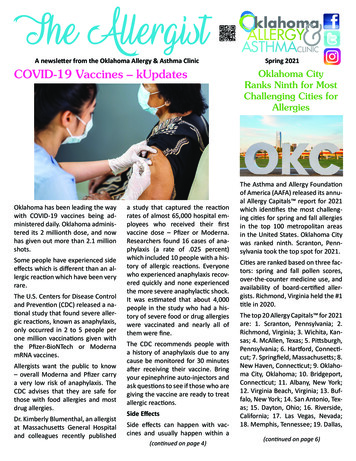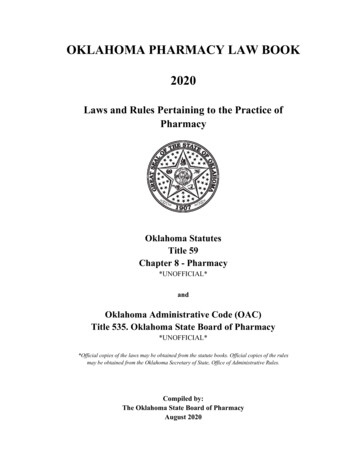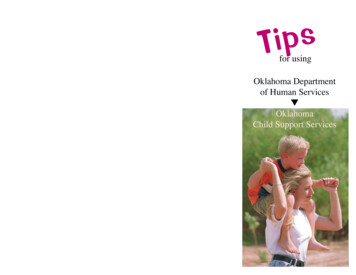
Transcription
The AllergistA newsletter from the Oklahoma Allergy & Asthma ClinicCOVID-19 Vaccines – kUpdatesOklahoma has been leading the waywith COVID-19 vaccines being administered daily. Oklahoma administered its 2 millionth dose, and nowhas given out more than 2.1 millionshots.Some people have experienced sideeffects which is different than an allergic reaction which have been veryrare.The U.S. Centers for Disease Controland Prevention (CDC) released a national study that found severe allergic reactions, known as anaphylaxis,only occurred in 2 to 5 people perone million vaccinations given withthe Pfizer-BioNTech or ModernamRNA vaccines.Allergists want the public to know– overall Moderna and Pfizer carrya very low risk of anaphylaxis. TheCDC advises that they are safe forthose with food allergies and mostdrug allergies.Dr. Kimberly Blumenthal, an allergistat Massachusetts General Hospitaland colleagues recently publisheda study that captured the reactionrates of almost 65,000 hospital employees who received their firstvaccine dose – Pfizer or Moderna.Researchers found 16 cases of anaphylaxis (a rate of .025 percent)which included 10 people with a history of allergic reactions. Everyonewho experienced anaphylaxis recovered quickly and none experiencedthe more severe anaphylactic shock.It was estimated that about 4,000people in the study who had a history of severe food or drug allergieswere vaccinated and nearly all ofthem were fine.The CDC recommends people witha history of anaphylaxis due to anycause be monitored for 30 minutesafter receiving their vaccine. Bringyour epinephrine auto-injectors andask questions to see if those who aregiving the vaccine are ready to treatallergic reactions.Side EffectsSide effects can happen with vaccines and usually happen within a(continued on page 4)Spring 2021Oklahoma CityRanks Ninth for MostChallenging Cities forAllergiesThe Asthma and Allergy Foundationof America (AAFA) released its annual Allergy Capitals report for 2021which identifies the most challenging cities for spring and fall allergiesin the top 100 metropolitan areasin the United States. Oklahoma Citywas ranked ninth. Scranton, Pennsylvania took the top spot for 2021.Cities are ranked based on three factors: spring and fall pollen scores,over-the-counter medicine use, andavailability of board-certified allergists. Richmond, Virginia held the #1title in 2020.The top 20 Allergy Capitals for 2021are: 1. Scranton, Pennsylvania; 2.Richmond, Virginia; 3. Wichita, Kansas; 4. McAllen, Texas; 5. Pittsburgh,Pennsylvania; 6. Hartford, Connecticut; 7. Springfield, Massachusetts; 8.New Haven, Connecticut; 9. Oklahoma City, Oklahoma; 10. Bridgeport,Connecticut; 11. Albany, New York;12. Virginia Beach, Virginia; 13. Buffalo, New York; 14. San Antonio, Texas; 15. Dayton, Ohio; 16. Riverside,California; 17. Las Vegas, Nevada;18. Memphis, Tennessee; 19. Dallas,(continued on page 6)
Exercise-Induced Anaphylaxis Rare;Can be Life ThreateningExercised-induced anaphylaxis (EIA)is a severe and rare allergic reactiontriggered by physical activity. EIA canstart at any age, usually between 4to 74) and can be life threatening. In30 to 50 percent of cases, EIA is fooddependent which means that thecombination of a specific food withexercise caused the reaction.SymptomsMost warning signs happen within30 minutes after starting exercise,although it can start at any time,even several hours later. EIA can improve once exercising has stopped.It can worsen severely once exercisecontinues. Rapidly spreading redness andwarmth of skin Widespread itchiness Hives Sudden fatigue Headache Gastrointestinal symptoms: nausea, vomiting, diarrhea and abdominal cramping Difficulty in breathing with thefeeling of choking Wheezing Chest tightness Swelling of the face, throat,hands and/or feet Low blood pressure Altered consciousness.Sports Medicine Evaluation andTreatmentThe diagnosis of EIA is very complex.It’s extremely important to document the details of what happenedduring the EIA episodes. Your allergist may order an exercise-challengetest, allergy skin test, food challeng2 Do not exercise four to six hoursafter eating Before exercising, avoid triggerssuch as aspirin, NSAIDs and foodallergens Treating anaphylactic shock startswith recognizing the symptomsand immediately stopping exercise.Check the ABCs (airway, breathing and circulation) and then injectepinephrine using an EpiPen intothe outer thigh. Call 9-1-1 and seekimmediate medical care for furthermonitoring and treatment, as theanaphylactic reaction might haveongoing life-threatening effects.Don’t exercise around menstrualcycles and extreme temperaturechanges Use prophylactic mediationssuch as antihistamines Stop exercise at the first signof itchiness, skin redness andwarmth, hives or fatigue to prevent progression of EIA Exercise with a partner whoknows how to inject epinephrineand perform basic life support(CPR)Once in the hospital, the doctor mayprescribe oxygen and mediationslike antihistamines, inhaled bronchodilators, antacids and steroids tohelp with the symptoms.Return to Playing test or methacholine-challengetest to make the diagnosis clearerand identify what factors triggeredthe reaction. A positive test confirms the diagnosis, but a negativetest does not prove that EIA did notoccur.TreatmentInjury Prevention Modification of activities andbehavior is important to preventEIA.Athletes with history of EIA shouldnot participate in activity until acomprehensive anaphylaxis plan isput into place. The athlete shouldprogress to higher amounts of exercise intensity and duration, whilekeeping it below the threshold thatcauses symptoms of anaphylaxis.
Studies link Vaping to Asthma – COPDIf you thought vaping was a safer alternative than smoking, especiallythose who have lung diseases, thinkagain. New research links the use ofelectronic cigarettes to asthma andchronic obstructive pulmonary disease (COPD).E-cigarettes have been around inthe United States for more than adecade. They were marketed as lessharmful than traditional tobaccocigarettes and to help quit smoking.In 2016, almost 11 million Americanadults used e-cigarettes.A recent study published in theAmerican Journal of PreventativeMedicine found that e-cigarette users are at significantly higher riskof developing chronic lung diseasessuch as asthma, bronchitis, emphysema, and COPD.Vaping has been linked to a nationwide outbreak of serious lung illness– many with adding the THC component from marijuana which produces a high. An additive called Vitamin“The Allergist” is published quarterly by theOklahoma Allergy & Asthma Clinic. Contentsare not intended to provide personal medicaladvice, which should be obtained directly froma physician.“The Allergist” welcomes your letters,comments or suggestions for future issues.Send to:The Allergist750 NE 13th StreetOklahoma City, OK 73104-5051Phone: 405-235-0040www.oklahomaallergy.comOklahoma Allergy & Asthma ClinicEditorial Advisory BoardDean A. Atkinson, M.D.Laura K. Chong, M.D.Scott B. Dennis, MHAMaya N. Gharfeh, M.D.Richard T. Hatch, M.D.Bret R. Haymore, M.D.Gregory M. Metz, M.D.Patricia I. Overhulser, M.D.Shahan A. Stutes, M.D.Karen L. Gregory, DNPChelsea E. Robinson, APRN-CNPStefanie E. Rollins, APRN-CNP, AE-CElisa C. Thompson, APRN-CNPE acetate that makes the THC lastlonger may be the cause accordingto the U.S. Centers for Disease Control and Prevention.The study lead by Dr. Albert Osei, apostdoctoral fellow at Johns Hopkins University School of Medicinein Baltimore, looked at a database ofmore than 705,000 adults. Almost65,000 smoked regular cigarettes.More than 25,000 smoked e-cigarettes with an average age 30 to 34.More than 200,000 were former traditional smokers.About 2 percent of the smokers usedboth traditional and e-cigarettes.More than 53,000 in the group saidthey had COPD, chronic bronchitis,or emphysema.For those who never smoked regular cigarettes, e-cigarette use was associated with higher odds of COPD.Daily users of e-cigarettes had 2.6times higher odds of COPD thanpeople who never smoked regularcigarettes.A second study published in thejournal BMC Pulmonary Medicineincluded more than 400,000 adultswho never smoked regular cigarettes. More than 34,000 had asthma and 3,100 used e-cigarettes withan average age of 18 to 24.The risk of asthma was 39 percenthigher in current e-cigarette usersthan in people who had never vaped.The more people vaped, the highertheir chance of getting asthma.“Long gone are the days when makers of e-cigarettes could claim thatthis form of nicotine use was notharmful,” said Dr. Len Horovitz, apulmonary specialist at Lenox HillHospital in New York City who reviewed the study findings. “There isno safe smoking or vaping.”Dr. Osei agreed.“The majority of people using electronic cigarettes are young people.Over time, we will have a generationwho becomes nicotine dependentfrom using electronic cigarettes,”Osei said. “As a public health physician, I cannot say that electroniccigarettes are without risk.”Remember to Follow OAAC onFacebook, Twitter & InstagramIn addition to posting pollen and moldcounts each day, OAAC also uses socialmedia to post announcements oreducational allergy news updates.Follow us on Facebookat er @ okallergyasthmaInstagram @oklahomaallergyasthmaclinic3
COVID-19 Allergic Updates.(continued from page 1)few hours and up to a day after vaccination. About 60 percent of thosein the clinical trials of the three vaccines reported side effects – armsoreness at the injection site and orfatigue, headache, muscle or jointpain, fever, chills or nausea. Side effects usually go away in a few days.Suspected Allergy TriggersThe mRNA vaccines are not madewith any food or animal productproteins that can trigger IgE reactions. IgE is considered the allergyantibody, Some experts suggest avaccine reaction to polyethylene glycol (PEG) could have triggered an allergic response for 16 Mass Generalemployees who participated in thestudy. However, PEG allergy is veryrare. PEG and polysorbate in the J&Jvaccine are in everyday productsused by consumers like cosmetics,toothpaste, and laxatives.Covid ArmDelayed skin reactions, an angry redrash around the site of the vaccinehas also been called Covid arm. Asmall amount of the patients in thestudy (12) developed a red, tenderand even itchy welt about a weekafter their first Pfizer or Modernashot. Rashes can be associated withan allergy. However, delayed skin reactions can be a signal the immunesystem is kicking in with the vaccineworking rather than an allergic reaction. Use of antihistamines and topical steroid cream solved the issuefor most in the study. Talk to yourOAAC allergist if your symptoms aremore severe.Second Shot Side EffectsSome side effects have included fatigue, muscle pain, headache and fever and chills which tend to be moreintense after the second shot. The4second dose acts as a booster to ensure the immune system is ready tomount a full-blown attack. Youngeradults with more vigorous immunesystems seem to be having moreside effects rather than older adults.However, if no side effect is experienced, that is normal also.Treatment for side effects after youreceive the shots such as musclepain or fever, the CDC recommendstaking acetaminophen or ibuprofen.Do not take these medications before the shot because it might curbthe immune system’s response tothe vaccines.Breaking News: The CDChas halted Johnson andJohnson Covid vaccinesdue to reports of bloodclotsexperiencedinsome people. Furtherinformation is pending.
Allergy Capitals.(continued from page 1)Texas; and 20. Louisville, Kentucky.Tulsa, Oklahoma was ranked 21.“Allergies are a serious public healthconcern. More than 24 million people in the U.S. have seasonal allergicrhinitis, more commonly referredto as hay fever. Pollen allergies area major cause. AAFA’s Allergy Capitals report helps more Americansmake sense of the impact on individual and community health,” saysKenneth Mendez, CEO and president of AAFA. “Two notable parts ofour 2021 report include the effectof COVID-19 and climate change onseasonal allergies. In 2020, fewerpeople felt the impact of pollen allergies. This is likely due to COVID-19restrictions with more people staying indoors. But climate changecontinues to cause longer and moresevere allergy seasons. If we don’tslow down the cycle, pollen production will only intensify. This meanssymptoms could worsen as climatechange continues to evolve.”Seasonal pollen allergies cause nasal, sinus, and other symptoms eachspring through fall. Pollen can alsotrigger asthma attacks. Tree pollenseason starts as early as January insome parts of the U.S. and continuesthrough summer. In the fall, weedpollen including ragweed, causessymptoms. But relief is possible withthe right treatment and by managing contact with pollen. OklahomaCity just had several allergy alertdays in April for tree pollen whichis always problematic in the wintermonths.“It’s important people with seasonalallergies prepare. They should trytheir best to reduce exposure to pollen,” says Dr. Mitchell Grayson, chairof AAFA’s Medical Scientific Counciland Director of the Division of Allergy and Immunology at Nationwide Children’s Hospital and TheOhio State University. “Schedule anappointment with your allergist towork on a treatment plan togetherto help reduce allergy symptomswhen prevention is not enough.”Immediate appointments are available!Board CertifiedAllergist Dr.Maya Gharfehis now seeingpatients at ourMidwest Cityand NormanClinicsStefani Rollins,APRN-CNP,AE-C, is nowseeing patientson Mondays,Tuesdays andWednesdays inNormanElisaThompson,APRN-CNP,has addedevery otherWednesdayto her currentschedule inEdmondChelseaRobinson,APRN-CNP, isnow seeingpatients at theMidwest Cityon FridaysDr. Laura Chong,OAAC Board Certified AllergistTreatment options include overthe-counter or prescription allergymedicines. Medications are most effective when started before allergyseason begins.“If medicines are not helping, it isimportant to establish care with anallergist to discuss what treatmentoptions are best to reduce your allergy symptoms and attacks,” saidOklahoma Allergy & Asthma BoardCertified Allergist Dr. Laura Chong.The Allergy Capitals ranking is anannual research and educationalproject of AAFA, designed to help patients recognize, prevent and safelytreat allergy symptoms. Throughthis ranking, AAFA raises awarenessabout the impact of seasonal allergies and provides helpful information designed to improve the quality of life for people who experiencethem. The ranking is based on localspring and fall pollen levels, use ofallergy medication and the numberof board-certified allergists in eachmetro area. Visit allergycapitals.comto see the full list, study methodology and learn more about allergy diagnosis, prevention and treatment.To see the complete, 100-city list goto allergycapitals.com. The reportlists overall annual rankings andbreaks down a seasonal ranking forspring and fall.5
The University of Oklahoma Health Sciences Center andthe Oklahoma Allergy & Asthma Clinic are looking forfamilies with a child with food allergy to participate ina research study!You may qualify for this study if: You are parent or guardian of a child witha physician-diagnosed food allergy Your child is a current patient of theOklahoma Allergy & Asthma Clinic You read, speak and understand EnglishTo participate in this study, visit https://redcap.link/foodallergyscreener or scan the QR scanthe QR code! Please contact us at anchor-lab@ouhsc.edu or 405-271-8001 ext. 44186 if youhave any questions or concerns.Psychosocial Outcomes in Pediatric Food AllergyPI: J. Carrick Carter, PsyDThe University of Oklahoma is an equal opportunity institution.IRB#104006
kins University School of Medicine in Baltimore, looked at a database of more than 705,000 adults. Almost 65,000 smoked regular cigarettes. More than 25,000 smoked e-ciga-rettes with an average age 30 to 34. More than 200,000 were former tra-ditional smokers. About 2 percent of the smokers used both traditional and e-cigarettes.











